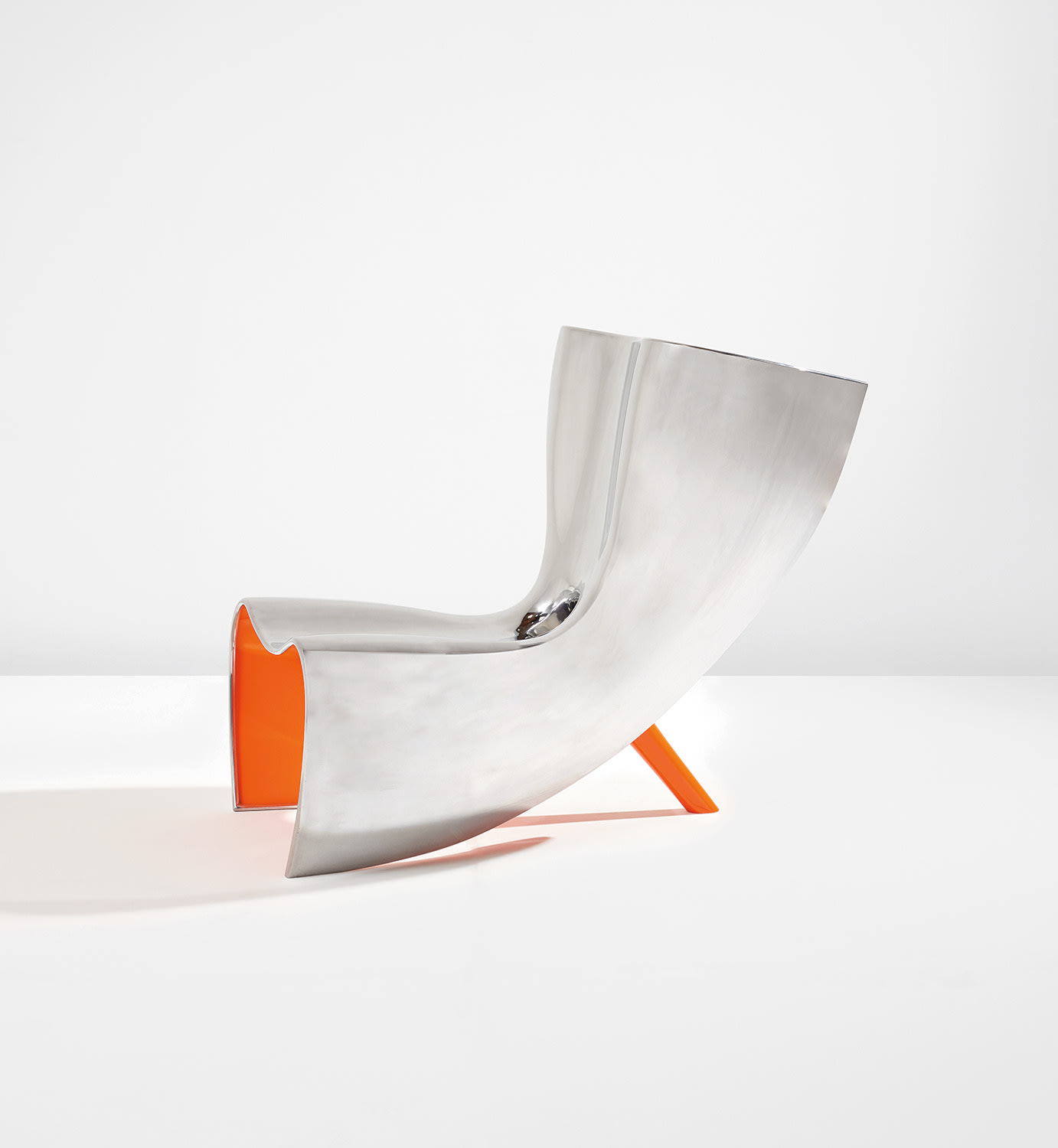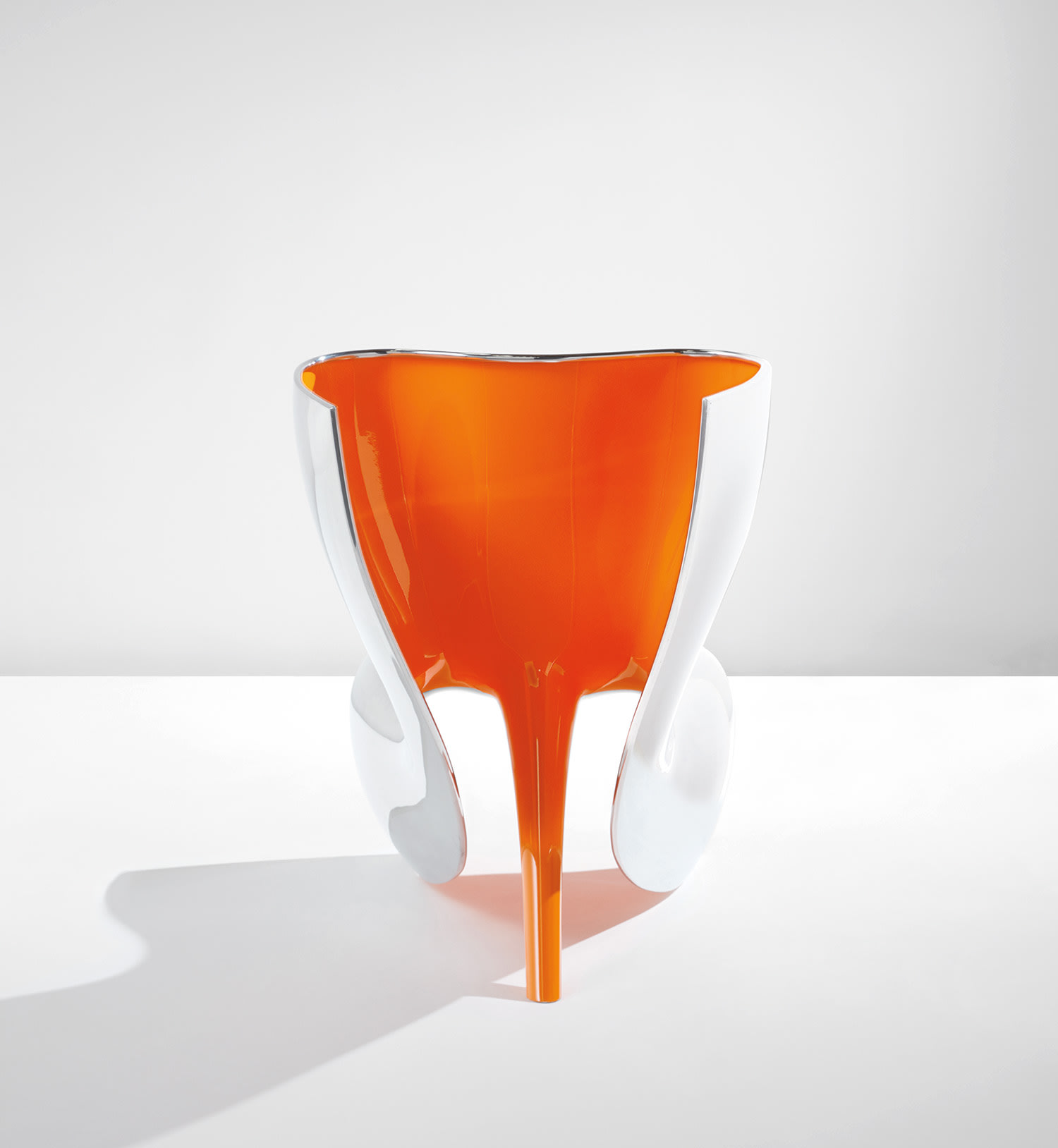



Property from an Important French Collection
71
Marc Newson
Prototype "Alufelt Chair"
circa 1993
Polished aluminum, lacquered aluminum.
34 1/2 x 25 3/4 x 37 3/8 in. (87.6 x 65.4 x 94.9 cm)
Produced by POD Edition, London. Prototype 1 from the edition of 6 plus 2 prototypes. Proper right side impressed with manufacturer's logo MARC NEWSON/POD/POD EDITION, 1 / 0 and artist's mark.
Full-Cataloguing
The present work will be included as "MN - 8AC - 1993" in the forthcoming Catalogue raisonné of limited editions by Marc Newson, currently being prepared by Didier Krzentowski - Galerie kreo, Paris.
Marc Newson’s Alufelt Chair
by Luke T. Baker
For Marc Newson, aluminum is as much his muse as it is his métier. During his 40-year career, the Australian industrial designer’s tireless devotion to and experimentation with aluminum has drawn him to weld, rivet, coil, beat, machine, anodize, and extrude the metal into gleaming, futuristic objects that play with volume and void, forms both familiar in their organicism and as sui generis as an alien spacecraft. The Alufelt Chair, a rippling ribbon of metal designed and released in a limited edition in 1993, portends a significant shift in Newson’s love affair with aluminum. Produced at the pinnacle of his achievement in metal fabrication, when Newson had discovered the means to transform aluminum into virtually anything he could envision, the Alufelt Chair finds the designer rejecting the alchemical impulse and exalting this malleable material in its most honest format: the two-dimensional plane of industrially produced sheet metal.
For the decade before the Alufelt Chair was designed, Newson had been on an obsessive quest to create an aluminum chair that looked just like a bead of mercury or a molten drop of metal: volumetric, seamless, without a trace of the maker’s hand. He approached the prototyping and DIY fabrication of his early attempts with a gamely appetite for trial and error, though for years, the illusory effect would prove elusive. Newson first started by attempting to weld thin squares of aluminum together, then switched to riveting them over a fiberglass form with his now-iconic Lockheed Lounge of 1988. With the Coil Chair prototype of 1989, he tried wrapping aluminum wire around a metal frame. Several years later, he partnered with a French manufacturer of precision aluminum aircraft components and got closer to his ideal with the sleek, surfboard-like Event Horizon table of 1992. It wasn’t until 1993, when Newson encountered the expert aluminum panel shapers at Bodylines, an English auto body shop specializing in classic car restoration, that he was able to create the fluid look he had long sought in the Orgone Chair and Orgone Stretch Lounge.
Produced at the same moment, in the same shop, by the same team of craftsmen, the Alufelt Chair summarily deconstructed the illusionistic metal fabrication techniques Newson had only just perfected. Alufelt shares the same bulbous, hourglass shape and polished surface of the Orgone designs, but unlike those seamless, tubular works, its form is not fully enclosed. Instead, Newson left a conspicuous split along the back of the chair that exposed its enameled interior and splayed the edges of the sheet metal “skin” into self-supporting legs, transforming the Orgone Chair’s extruded macaroni shape into a folded farfalle. The chair’s brightly colored underside highlights the dualism between obverse and reverse, and its stiletto-like rear leg appears to funnel away from the seat’s surface, forming a hollow vortex in the horizontal plane and further reinforcing its flatness.
The Alufelt’s complex folded plane is a shape Newson had explored earlier with his Felt Chair prototypes of 1989 and Wicker Chair of 1990, but re-editioned in aluminum, the design feels satisfyingly authentic to its medium. We can recognize its origins in a two-dimensional piece of metal, we can grasp the physics by which it was bent into shape, and we can even begin to picture how to approximate its form by curling up a piece of paper or manipulating a piece of clay. While it doesn’t quite betray all the secrets of its construction (welds where the side segments and conical leg were attached have been planished and polished away), the Alufelt Chair pulls back the curtain to share something of the magic by which it was made. By flexing its flamboyant planarity, the chair not only reveals, but revels in the fact that its voluptuous, three-dimensional profile has been conjured, though a feat of virtuosic metalworking, from a humble sheet of aluminum.
Marc Newson’s Alufelt Chair
by Luke T. Baker
For Marc Newson, aluminum is as much his muse as it is his métier. During his 40-year career, the Australian industrial designer’s tireless devotion to and experimentation with aluminum has drawn him to weld, rivet, coil, beat, machine, anodize, and extrude the metal into gleaming, futuristic objects that play with volume and void, forms both familiar in their organicism and as sui generis as an alien spacecraft. The Alufelt Chair, a rippling ribbon of metal designed and released in a limited edition in 1993, portends a significant shift in Newson’s love affair with aluminum. Produced at the pinnacle of his achievement in metal fabrication, when Newson had discovered the means to transform aluminum into virtually anything he could envision, the Alufelt Chair finds the designer rejecting the alchemical impulse and exalting this malleable material in its most honest format: the two-dimensional plane of industrially produced sheet metal.
For the decade before the Alufelt Chair was designed, Newson had been on an obsessive quest to create an aluminum chair that looked just like a bead of mercury or a molten drop of metal: volumetric, seamless, without a trace of the maker’s hand. He approached the prototyping and DIY fabrication of his early attempts with a gamely appetite for trial and error, though for years, the illusory effect would prove elusive. Newson first started by attempting to weld thin squares of aluminum together, then switched to riveting them over a fiberglass form with his now-iconic Lockheed Lounge of 1988. With the Coil Chair prototype of 1989, he tried wrapping aluminum wire around a metal frame. Several years later, he partnered with a French manufacturer of precision aluminum aircraft components and got closer to his ideal with the sleek, surfboard-like Event Horizon table of 1992. It wasn’t until 1993, when Newson encountered the expert aluminum panel shapers at Bodylines, an English auto body shop specializing in classic car restoration, that he was able to create the fluid look he had long sought in the Orgone Chair and Orgone Stretch Lounge.
Produced at the same moment, in the same shop, by the same team of craftsmen, the Alufelt Chair summarily deconstructed the illusionistic metal fabrication techniques Newson had only just perfected. Alufelt shares the same bulbous, hourglass shape and polished surface of the Orgone designs, but unlike those seamless, tubular works, its form is not fully enclosed. Instead, Newson left a conspicuous split along the back of the chair that exposed its enameled interior and splayed the edges of the sheet metal “skin” into self-supporting legs, transforming the Orgone Chair’s extruded macaroni shape into a folded farfalle. The chair’s brightly colored underside highlights the dualism between obverse and reverse, and its stiletto-like rear leg appears to funnel away from the seat’s surface, forming a hollow vortex in the horizontal plane and further reinforcing its flatness.
The Alufelt’s complex folded plane is a shape Newson had explored earlier with his Felt Chair prototypes of 1989 and Wicker Chair of 1990, but re-editioned in aluminum, the design feels satisfyingly authentic to its medium. We can recognize its origins in a two-dimensional piece of metal, we can grasp the physics by which it was bent into shape, and we can even begin to picture how to approximate its form by curling up a piece of paper or manipulating a piece of clay. While it doesn’t quite betray all the secrets of its construction (welds where the side segments and conical leg were attached have been planished and polished away), the Alufelt Chair pulls back the curtain to share something of the magic by which it was made. By flexing its flamboyant planarity, the chair not only reveals, but revels in the fact that its voluptuous, three-dimensional profile has been conjured, though a feat of virtuosic metalworking, from a humble sheet of aluminum.